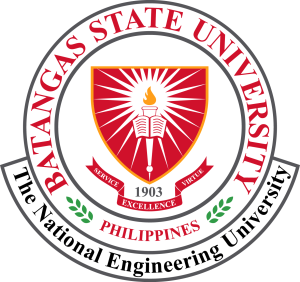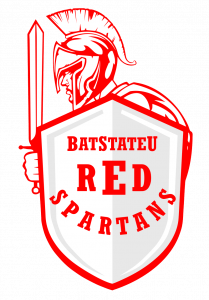BatStateU The NEU rises to 111th place in 2025 WURI Rankings, solidifying its role as a leader in innovation

Batangas State University, The National Engineering University (BatStateU The NEU), has advanced to 111th place in the 2025 World University Rankings for Innovation (WURI), positioning itself among the top 400 innovative universities globally. This move from 128th place last year highlights BatStateU’s ongoing commitment to innovation, academic excellence, and societal impact, further solidifying its status as a recognized global leader in higher education. Out of 1,253 universities from 87 countries that participated, BatStateU’s achievement underscores its prominence on the world stage. The WURI evaluates universities based on their practical contributions to society and industry, focusing on innovation in education, research, and community engagement. BatStateU’s rise reflects its strong emphasis on providing real-world solutions in key areas such as crisis management, environmental sustainability, and technological infrastructure. “This achievement reflects BatStateU’s dedication to innovative solutions that create meaningful impact on our society,” said Dr. Tirso A. Ronquillo, University President. “It affirms our commitment to developing cutting-edge programs that address both global and local challenges,” he added. In addition to its overall ranking, BatStateU The NEU excelled in three specific categories within the WURI 2025: ● Crisis Management (15th place out of 73) – BatStateU’s disaster preparedness initiatives, including the Batangas State University Command Center and community-driven programs such as the Safe Spartan App and Community-Based Monitoring and Mapping System (CBMMS), demonstrate its leadership in crisis management. ● Environmental, Social, and Governance (ESG)Trend (21st place out of 47) – BatStateU has led initiatives like the Batangas Actions towards Revitalization and Acceleration of Kapeng BarakO Industry(BARAKO) Project and the Understanding PhysioLogical Vulnerability of UlvA spp.(ULVA) Project that focus on sustainable practices, revitalizing localindustries, and addressing environmental vulnerabilities. ● Infrastructure/Technologies (24th place out of 100) – Projects like BIOtechnology INnovations Shaping Progress in Industry, Research, and Environment (BIO-INSPIRE), a biotechnology innovation initiative, and Beyond Paywall, which seeks to make IC design more accessible, highlight BatStateU’s leadership in technological advancements. This ranking reinforces BatStateU’s commitment to advancing innovation and sustainable development in alignment with the United Sustainable Development Goals (SDGs). Through its focus on technology,research, and sustainability, BatStateU continues to drive meaningful change, not only in education but also in real-world applications. Batangas State University, designated as the Philippines’ Engineering University through Republic Act No. 11694, is widely recognized for its excellence in engineering education. A Level-IV state university, it has produced over 180 engineering board topnotchers, solidifying its reputation as the country’s largest engineering university. Notably, BatStateU is also a pioneer in quality assurance for engineering education. It is the first state university with programs in BS Chemical Engineering, BS Civil Engineering, BS Computer Engineering, BS Electrical Engineering, BS Electronics Engineering, BS Industrial Engineering, BS Mechanical Engineering, and BS Sanitary Engineering accredited by the Engineering Accreditation Commission (EAC) of the Accreditation Board for Engineering and Technology (ABET), https://www.abet.org under the commission’s General Criteria and Program Criteria for Engineering and Philippine Technological Council’s Accreditation and Certification Board for Engineering and Technology (PTC-ACBET). Moreover, BatStateU Alangilan’s BS Computer Science Program is accredited by the Computing Accreditation Commission of ABET, https://www.abet.org under the commission’s General Criteria and Program Criteria for Computer Science and Similarly Named Computing Programs. Similarly, BatStateU Alangilan’s BS Information Technology Program is accredited by the Computing Accreditation Commission of ABET, https://www.abet.org under the commission’s General Criteria and Program Criteria for Information Technology and Similarly Named Computing Programs. With its recent achievement in the 2025 Times Higher Education (THE) Impact Rankings, where BatStateU ranked between 401-600 globally, BatStateU has also earned global recognition for its commitment to sustainability, ranking as the 304th Most Sustainable University in the 2024 UI GreenMetric World University Rankings. For more information about WURI, please visit https://www.wuri.world/wuri-ranking-2025.
Building Information Modeling (BIM) Autodesk Revit Structure

HOME REGISTER 24 HOURS IN PERSON ENGLISH 28 HOURS IN PERSON ENGLISH HOME REGISTER This training course is intended to teach the concepts and principles from building design through construction documentation using the Autodesk® Revit® Architecture software. What You’ll Learn Students will gain a comprehensive skill set and advanced skills in Revit in a structural environment and will be knowledgeable in relevant workflows, processes, and project objectives. Skills You’ll Gain Building Information Modeling Structural Modeling and Detailing Roles Civil/Structural Engineer Structural Draftsman Detailers What You’ll Learn Students will gain a comprehensive skill set and advanced skills in Revit in a structural environment and will be knowledgeable in relevant workflows, processes, and project objectives. Skills You’ll Gain Building Information Modeling Structural Modeling and Detailing Role Civil/Structural Engineer Structural Draftsman Detailers Course Outline Module 1:Introduction to BIM and Revit Structures Module 2: Structural Modeling – Part 1 Module 3: Structural Modeling – Part 2 Module 4: Scheduling and Documentation – Part 1 Module 5: Documentation – Part 2 Required Resources Hardware: 64-bit Microsoft® Windows® 10 or Windows 11; Intel® i-Series, Xeon®, AMD® Ryzen, Ryzen Threadripper PRO. 2.5GHz or Higher; 32 GB RAM; 1920 x 1200 with true color; minimum of 4GB of video memory; 30 GB free disk space; 10,000+ RPM HardDrive (for Point Cloud interactions) or Solid-State DriveSoftware: Autodesk RevitNetwork: Adequate Internet Connection Pre-Requisites Navigate the Revit interface.View and navigate a Revit model.Understand the concept of architectural 3D modeling.Create and modify basic 3D elements, annotations, and views.Demonstrate basic digital literacy skills. Assessment In this BIM Revit Structure Fundamentals course, there will be Practical Assessment: Hands-on activities are prepared for this course to assess the attainment of learning outcomes. Final Assessment: This exam measures your ability to create, modify and manage a structural project using Revit Structures. Credit and Recognition Upon completing the BIM Revit Structure Fundamentals course, learners will receive a Certificate of Completion and a badge. The credit will be recognized as a prerequisite requirement to a more advanced course under the BIM. This course is accredited by Autodesk and is facilitated by an Autodesk Certified professional. Learning Pathways This BIM Structure Course is stackable for “Building Information Modeling: Revit Architecture” microcredential course.
Project Planning and Control using Primavera P6-Advanced

HOME REGISTER 16 HOURS IN PERSON ENGLISH 16 HOURS IN PERSON ENGLISH HOME REGISTER This comprehensive course is designed to cater to learners aspiring to master advanced planning and scheduling principles, coupled with hands-on application using Primavera P6. Through the seamless integration of essential topics such as Earned Value Management (EVM) and other foundational planning concepts, students who complete this program will acquire the skills to adeptly oversee their projects adeptly, ensuring attaining desired outcomes with precision and efficiency. What You’ll Learn At the end of this course, you will acquire robust knowledge related to project management and control using the Primavera P6 software. You will be well-prepared to take on complex projects, develop comprehensive project plans, monitor progress, manage resources effectively, control costs, and ensure successful project outcomes using Primavera P6 as a powerful tool. Skills You’ll Gain Project management Project planning Roles Project Planner Scheduler Project Scheduling and Control Specialist What You’ll Learn At the end of this course, you will acquire robust knowledge related to project management and control using the Primavera P6 software. You will be well-prepared to take on complex projects, develop comprehensive project plans, monitor progress, manage resources effectively, control costs, and ensure successful project outcomes using Primavera P6 as a powerful tool. Skills You’ll Gain Project management Project planning Role Project Planner Scheduler Project Scheduling and Control Specialist Course Outline Module 1: Expenses, Level of Effort, Filters and Gantt Chart Module 2: Importing and Exporting Data, Codes and Portfolios Module 3: User-Defined Fields, Global Change, Duration types and Advanced Scheduling Module 4: Percent Complete and Earned Value Management Reqired Resources To run Primavera P6: Modern, fast processor (multi-core recommended), 4GB RAM (8GB recommended), 20GB+ free disk space (Hardware); Windows 10 or higher, Oracle Database or Microsoft SQL Server, Microsoft .NET Framework (Software); Required for installation, updates, and remote database access (Network) Pre-Requisites Ability to use a personal computer and an understanding of how projects are planned, scheduled, and controlled; completed course Project Planning and Control using Primavera P6 – Fundamentals Assessment In this Project Planning and Control using Primavera P6 – Advanced course, there will be: One (1) summative assessment, conducted synchronously which is performance-based allowing learners to participate on-site. Credit and Recognition Upon completing the Project Planning and Control using Primavera P6, learners will receive a Certificate of Completion and a badge. These serve both as a recognition of acquired project planning and control expertise and a foundational step toward more advanced studies in said field. This course was co-developed and is co-delivered with CIM Technologies, Inc, one of the Philippine’s leaders in providing world-class project management tools and education services for Project Management to various local and international companies across Architecture, Engineering and Construction (AEC) and Manufacturing industries. To ensure the quality of this microcredential, continuous feedback loops with students, instructors, and industry practitioners are maintained to continuously improve content, delivery, and assessment methods. Learning Pathways Project Planning and Control using Primavera P6 – Advanced: “Project Planning and Control using Primavera P6 – Fundamentals” is a prerequisite for this advanced course, ensuring that you have the essential foundational knowledge to excel in the more advanced aspects of project planning and control using Primavera P6.
Building Information Modeling Bim Autodesk Revit Architecture
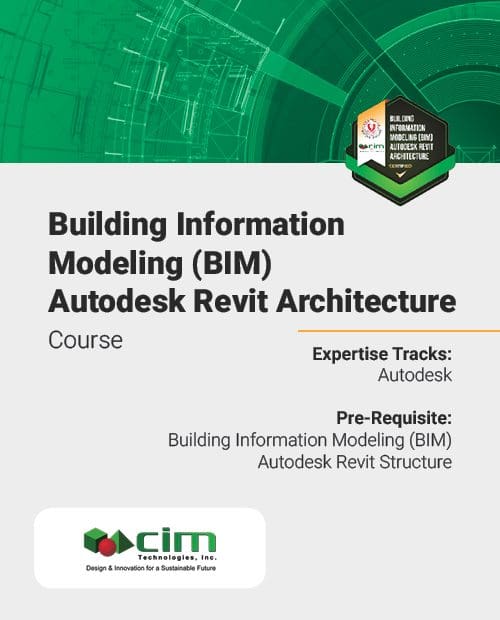
HOME REGISTER 24 HOURS IN PERSON ENGLISH 20 HOURS IN PERSON ENGLISH HOME REGISTER This training course is intended to teach the concepts and principles from building design through construction documentation using the Autodesk® Revit® Architecture software. What You’ll Learn Students will gain a comprehensive skill set and advanced skills in Revit in a structural environment and will be knowledgeable in relevant workflows, processes, and project objectives. Skills You’ll Gain Building Information Modeling Architectural Modeling and Detailing Roles Architects Draftsman Detailers What You’ll Learn Students will gain a comprehensive skill set and advanced skills in Revit in a structural environment and will be knowledgeable in relevant workflows, processes, and project objectives. Skills You’ll Gain Building Information Modeling Architectural Modeling and Detailing Role Architects Draftsman Detailers Course Outline Module 1: Introduction to BIM and Revit Architecture Module 2: Architectural Modeling Module 3: Revit Components Module 4: Documentation – Part 1 Module 5: Documentation – Part 2 Required Resources Hardware: 64-bit Microsoft® Windows® 10 or Windows 11; Intel® i-Series, Xeon®, AMD® Ryzen, Ryzen Threadripper PRO. 2.5GHz or Higher; 32 GB RAM; 1920 x 1200 with true color; minimum of 4GB of video memory; 30 GB free disk space; 10,000+ RPM HardDrive (for Point Cloud interactions) or Solid-State Drive Software: Autodesk Revit Network: Adequate Internet Connection Pre-Requisites Navigate the Revit interface.View and navigate a Revit model.Understand the concept of architectural 3D modeling.Create and modify basic 3D elements, annotations, and views.Demonstrate basic digital literacy skills Assessment In this BIM Revit Architecture course, there will be Practical Assessment: Hands-on activities are prepared for this course to assess the attainment of learning outcomes. Final Assessment: This exam measures your ability to create, modify and manage a structural project using Revit Structures. The learner will receive a Certificate Badge with an indicated depth of learning. Credit and Recognition Upon completing the BIM Revit Architecture course, The learner will receive a Certificate Badge with an indicated depth of learning. This course is accredited by Autodesk and is facilitated by an Autodesk Certified professional. Learning Pathways This BIM Architecture Course is stackable for “Building Information Modeling: Revit Structure” microcredential course.
Project Planning and Control using Primavera P6-Fundamentals
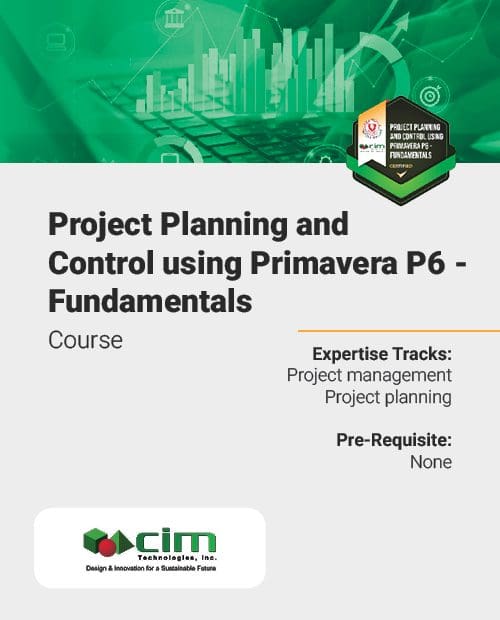
HOME REGISTER 24 HOURS IN PERSON ENGLISH 20 HOURS IN PERSON ENGLISH HOME REGISTER This comprehensive 20-hour course equips learners with essential project management skills while introducing them to Primavera P6. This powerful project management solution seamlessly integrates traditional project management techniques with user-friendly resource and cost management approaches. While Primavera P6 is commonly associated with construction, its versatility extends across diverse sectors, including banking, IT, government, and healthcare. It demonstrates its widespread applicability thereby making this course ideal for individuals who want to have necessary competencies in effectively handling large-scale, highly sophisticated and multifaceted projects. What You’ll Learn Upon completing this course, you will possess the competency to effectively employ Primavera P6’s fundamental features and functionalities within your organization’s project management workflows. You can craft detailed project schedules and establish a solid baseline schedule. Additionally, you will excel at project initiation and supervision, optimizing resource utilization to maximize the delivery of project objectives and outcomes. Skills You’ll Gain Project management Project planning Roles Project Planner Scheduler Project Scheduling and Control Specialist What You’ll Learn Upon completing this course, you will possess the competency to effectively employ Primavera P6’s fundamental features and functionalities within your organization’s project management workflows. You can craft detailed project schedules and establish a solid baseline schedule. Additionally, you will excel at project initiation and supervision, optimizing resource utilization to maximize the delivery of project objectives and outcomes. Skills You’ll Gain Project management Project planning Role Project Planner Scheduler Project Scheduling and Control Specialist Course Outline Module 1: Introduction, Navigation and Project Creation Module 2: Calendars, WBS and Activities Module 3: Display, Relationships and Scheduling Module 4: Resources and Exporting and Importing of Files Module 5: Printing, Report and Basics of Baselining Required Resources To run Primavera P6: Modern, fast processor (multi-core recommended), 4GB RAM (8GB recommended), 20GB+ free disk space (Hardware); Windows 10 or higher, Oracle Database or Microsoft SQL Server, Microsoft .NET Framework (Software); Required for installation, updates, and remote database access (Network) Pre-Requisites Ability to use a personal computer and an understanding of how projects are planned, scheduled, and controlled Assessment In this Project Planning and Control using Primavera P6 – Fundamentals course, there will be: One (1) summative assessment, conducted synchronously which is performance-based allowing learners to participate on-site. Credit and Recognition Upon completing the Project Planning and Control using Primavera P6, learners will receive a Certificate of Completion and a badge. These serve both as a recognition of acquired project planning and control expertise and a foundational step toward more advanced studies in said field. This course was co-developed and is co-delivered with CIM Technologies, Inc., one of the Philippines’ leaders in providing world-class project management tools and education services for Project Management to various local and international companies across Architecture, Engineering and Construction (AEC) and Manufacturing industries. To ensure the quality of this microcredential, continuous feedback loops with students, instructors, and industry practitioners are maintained to improve content, delivery, and assessment methods continuously. Learning Pathways This Fundamentals Course is stackable and is a prerequisite for “Advanced Project Planning and Control using Primavera P6” microcredential course
Data Management

HOME REGISTER 23 HOURS ONLINE ENGLISH 20 HOURS HYBRID ENGLISH HOME REGISTER In this course, you will learn the basics of data concepts and how to use Microsoft Azure’s data services to manage them effectively. We will cover everything from relational and non-relational data, to big data and analytics, giving you a robust understanding of cloud data services available on Microsoft Azure. The course will guide you through the fundamentals of relational data and the database services offered by Azure. You’ll get to know how to work with non-relational data using Azure storage solutions and will be introduced to the capabilities of Azure Cosmos DB. Plus, we’ll shed light on large-scale data warehousing and how to make the most of real-time analytics and data visualization. This course is ideal for those who are looking to grasp database concepts in a cloud setting, and to gain a solid foundation in Microsoft Azure’s data services, whether you’re brushing up on basics or learning it all for the first time. What You’ll Learn At the end of this course, learners will be able to describe data concepts, roles, and services. They will also be adept at evaluating relational database service and non-relational data on Azure. Additionally, learners will be skilled in managing data analytics and visualization on Azure. Skills You’ll Gain Data Science Cloud Infrastructure Management Roles Database Administrator What You’ll Learn At the end of this course, learners will be able to describe data concepts, roles, and services. They will also be adept at evaluating relational database service and non-relational data on Azure. Additionally, learners will be skilled in managing data analytics and visualization on Azure. Skills You’ll Gain Data Science Cloud Infrastructure Management Roles Database Administrator Course Outline Module 1: Cloud Concepts Module 2: Azure Architecture and Services Module 3: Azure Management and Governance Module 4: Data Concepts Module 5: Relational Data Module 6: Non-relational Data Module 7: Data Analytics in Azure Reqired Resources Laptop, Intel Core i5 or higher, 16GB RAM, 1TB Storage, Graphics Card (Hardware); Microsoft Azure (Software); Adequate Internet Connection (Network) Pre-Requisites None Assessment In this Data Management course: One (1) diagnostic assessment is available, conducted synchronously and based on knowledge, with the flexibility for learners to choose between remote or on-site participation. Two (2) formative assessments are offered, one focusing on knowledge and the other on performance. Both are available asynchronously, allowing learners to complete them at their own pace, with the option for remote or on-site participation. A knowledge-based style summative assessment is scheduled to be conducted synchronously, providing learners with the choice of participating remotely or on-site. Credit and Recognition The learner is eligible to take the Microsoft Certified: Azure Fundamentals and Azure Data Fundamentals. This course is facilitated by a Microsoft Certified professional. To ensure the quality of this micro-credential, continuous feedback loops with students, instructors, and industry practitioners are maintained to continually improve content, delivery, and assessment methods. Learning Pathways Data Management is the foundational course for your journey in the world of data. Upon successful completion, you’ll have the choice to specialize further in:
Data Science
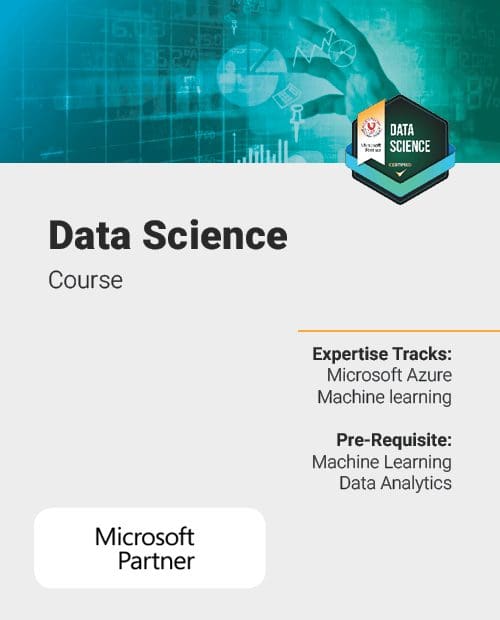
HOME REGISTER 46 HOURS ONLINE ENGLISH 46 HOURS ONLINE ENGLISH HOME REGISTER In this Data Science course, we will explore the vast field of machine learning leveraging the potential of Azure Machine Learning. Whether you’re building on your foundational knowledge of Python and machine learning or just getting started, this course will guide you through important aspects such as data ingestion, preparation, model training, and deployment. Plus, you’ll learn how to monitor machine learning solutions proficiently within the Microsoft Azure environment. It’s a course designed to give you the skills and knowledge to harness the full power of Azure in machine learning, helping you become proficient in data science. What You’ll Learn At the end of this course, learners will be able to describe what data science and machine learning are, including their applications & use cases, and the various types of tasks performed by data scientists. They will also be proficient in examining the Azure Machine Learning SDK tool. Furthermore, learners will be equipped to deploy, train, and analyze a model using Azure Machine Learning. Skills You’ll Gain Microsoft Azure Machine learning Roles Data Scientist AI Engineer What You’ll Learn At the end of this course, learners will be able to describe what data science and machine learning are, including their applications & use cases, and the various types of tasks performed by data scientists. They will also be proficient in examining the Azure Machine Learning SDK tool. Furthermore, learners will be equipped to deploy, train, and analyze a model using Azure Machine Learning. Skills You’ll Gain Microsoft Azure Machine learning Role Data Scientist AI Engineer Course Outline Module 1: Design a Machine Learning SolutionModule 2: Exploring Azure Machine LearningModule 3: Data Management in Azure MLModule 4: Working with Azure ML Compute ResourcesModule 5: No-Code Approaches in Azure MLModule 6: Automation in Model SelectionModule 7: Using Notebooks in Azure MLModule 8: Training Models using ScriptsModule 9: Optimization Techniques in Azure MLModule 10: Model Management TechniquesModule 11: Model Deployment and ConsumptionModule 12: Machine Learning Operations (MLOps) in Azure Required Resources Laptop, Intel Core i5 or higher, 16GB, 1TB Storage, Graphics Card (Hardware); Microsoft Azure (Software); Adequate Internet Connection (Network) Pre-Requisites This course is designed for data scientists with existing knowledge of Python and machine learning frameworks like Scikit-Learn, PyTorch, and Tensorflow, who want to build and operate machine learning solutions in the cloud. Assessment One (1) diagnostic assessment is available, conducted synchronously, and is knowledge-based, with the flexibility for learners to choose between remote or on-site participation. Two (2) formative assessments are offered, one focused on knowledge and the other on performance. Both are available asynchronously, allowing learners to complete them at their own pace, and learners have the option to participate remotely or on-site. A performance-based summative assessment is to be conducted synchronously, providing learners with the choice of remote or on-site participation. Credit and Recognition The learner is eligible to take the Microsoft Certified: Azure Data Scientist Associate. This course is facilitated by a Microsoft Certified professional. To ensure the quality of this micro-credential, continuous feedback loops with students, instructors, and industry practitioners are maintained to continually improve content, delivery, and assessment methods. Learning Pathways Data Science is the ultimate destination, and it can be reached through two distinct paths:Data Analytics: If you’re passionate about discovering actionable insights from data.Machine Learning: If you’re intrigued by the world of predictive modeling and artificial intelligence.
Data Engineering
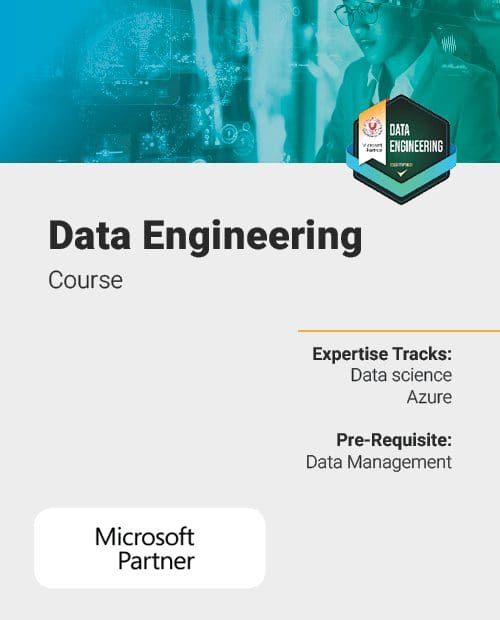
HOME REGISTER 32 HOURS ONLINE ENGLISH 65 HOURS ONLINE ENGLISH HOME REGISTER In this Data Engineering course, you will learn how to work with batch and real-time analytics solutions using the technology provided by the Azure data platform. The journey begins with understanding the core computing and storage technologies essential in building analytical solutions. You will discover how to explore data stored in data lakes interactively, using files as your guide. From there, we will cover the various techniques available for data ingestion using prominent tools such as Apache Spark in Azure Synapse Analytics or Azure Databricks, as well as Azure Data Factory or Azure Synapse pipelines. Not only will you learn how to bring data into your analytics systems, but you will also explore different methods to transform this data using the same ingestion tools. As we go further, we emphasize the critical role of security in protecting data whether it’s stored or being transferred. Towards the end, you will learn to create real-time analytics systems, opening doors to crafting solutions that work with data as it comes in, providing insights faster and more accurately. This course is designed to give you hands-on experience and a strong foundation in the fast-paced world of data engineering. What You’ll Learn At the end of this course, learners will be able to design and implement various stages and concepts in the data engineering lifecycle, including storage, processing, and security, in Microsoft Azure. Additionally, they will be capable of creating and performing data service operations, such as monitoring and optimization, in Microsoft Azure. Skills You’ll Gain Data science Azure Roles Data Engineer What You’ll Learn At the end of this course, learners will be able to design and implement various stages and concepts in the data engineering lifecycle, including storage, processing, and security, in Microsoft Azure. Additionally, they will be capable of creating and performing data service operations, such as monitoring and optimization, in Microsoft Azure. Skills You’ll Gain Data science Azure Role Data Engineer Course Outline Module 1: Get Started with Data Engineering on Azure Module 2: Build data analytics solutions using Azure Synapse serverless SQL pools Module 3: Perform data engineering with Azure Synapse Apache Spark Pools Module 4: Work with Data Warehouses using Azure Synapse Analytics Module 5: Transfer and transform data with Azure Synapse Analytics pipelines Module 6: Work with Hybrid Transactional and Analytical Processing Solutions using Azure Synapse Analytics Module 7: Implement a Data Streaming Solution with Azure Stream Analytics Module 8: Govern data across an enterprise Module 9: Data engineering with Azure Databricks Required Resources Laptop, Intel Core i5 or higher, 16GB, 1TB Storage, Graphics Card (Hardware); Microsoft Azure (Software); Adequate Internet Connection (Network) Pre-Requisites The primary audience for this course is data professionals, data architects, and business intelligence professionals who want to learn about data engineering and building analytical solutions using data platform technologies that exist on Microsoft Azure. The secondary audience for this course are data analysts and data scientists who work with analytical solutions built on Microsoft Azure. Assessment One (1) diagnostic assessment is available, conducted synchronously and is knowledge-based, with the flexibility for learners to choose between remote or on-site participation. Two (2) formative assessments are offered, one focused on knowledge and the other on performance. Both are available asynchronously, allowing learners to complete them at their own pace, and learners have the option to participate remotely or on-site. A performance-based summative assessment is to be conducted synchronously, providing learners with the choice of remote or on-site participation. Credit and Recognition The learner is eligible to take the Microsoft Certified: Azure Data Engineer Associate. This course is facilitated by a Microsoft Certified professional. To ensure the quality of this micro-credential, continuous feedback loops with students, instructors, and industry practitioners are maintained to continually improve content, delivery, and assessment methods. Learning Pathways Data Management is your prerequisite for entering the world of Data Engineering, where you’ll learn how to architect and manage data pipelines efficiently. Data Engineering is an essential step toward mastering Machine Learning.
Machine Learning

HOME REGISTER 19 HOURS ONLINE ENGLISH 19 HOURS ONLINE ENGLISH HOME REGISTER In this Machine Learning course, we will equip you with a strong foundation in the critical concepts and practical skills needed to work with classical machine learning models. The journey begins with understanding the core principles, supported by a healthy balance of theoretical knowledge and hands-on exercises to grasp various machine learning techniques and their practical applications. You’ll become adept at preprocessing and analyzing data, building resilient models, and evaluating their performance to make informed, data-driven decisions. Suitable for both beginners and those looking to build on their existing knowledge, this course aims to empower you with the competencies required to tackle real-world challenges effectively using classical machine learning models. What You’ll Learn At the end of this course, learners will be able to demonstrate a comprehensive understanding of the fundamental concepts, principles, and techniques of machine learning. They will also be equipped to apply their knowledge of machine learning to real-world scenarios. Furthermore, they will develop the ability to critically analyze and evaluate machine learning models, synthesize their knowledge and skills to construct and refine these models, and evaluate the effectiveness and performance of machine learning models. Skills You’ll Gain Microsoft Azure Machine learning Roles Data Scientist AI Engineer What You’ll Learn At the end of this course, learners will be able to demonstrate a comprehensive understanding of the fundamental concepts, principles, and techniques of machine learning. They will also be equipped to apply their knowledge of machine learning to real-world scenarios. Furthermore, they will develop the ability to critically analyze and evaluate machine learning models, synthesize their knowledge and skills to construct and refine these models, and evaluate the effectiveness and performance of machine learning models. Skills You’ll Gain Microsoft Azure Machine learning Role Data Scientist AI Engineer Course Outline Module 1: Introduction to Data for Machine LearningModule 2: Explore and Analyze Data with PythonModule 3: Train and Understand Regression Models in Machine LearningModule 4: Refine and Test Machine Learning ModelsModule 5: Train and Evaluate Regression ModelsModule 6: Create and Understand Classification Models in Machine LearningModule 7: Customize Architectures and Hyperparameters Using Random ForestModule 8: Confusion Matrix and Data ImbalancesModule 9: Optimize Model Performance with ROC and AUCModule 10: Train and Evaluate Classification ModelsModule 11: Train and Evaluate Clustering ModelsModule 12: Train and Evaluate Deep Learning Models Required Resources Laptop, Intel Core i5 or higher, 16GB, 1TB Storage, Graphics Card (Hardware); Microsoft Azure (Software); Adequate Internet Connection (Network) Pre-Requisites This course is designed for data scientists with existing knowledge of Python and machine learning frameworks like Scikit-Learn, PyTorch, and Tensorflow, who want to build and operate machine learning solutions in the cloud. Assessment In this Machine Learning course: One (1) diagnostic assessment is available, conducted synchronously, and is knowledge-based, with the flexibility for learners to choose between remote or on-site participation. Two (2) formative assessments are offered, one focused on knowledge and the other on performance. Both are available asynchronously, allowing learners to complete them at their own pace, and learners have the option to participate remotely or on-site. A performance-based summative assessment is to be conducted synchronously, providing learners with the choice of remote or on-site participation. Credit and Recognition Upon successful completion of the Machine Learning course, learners will receive a Certificate of Completion. This certificate serves both as a recognition of acquired expertise in machine learning and as a foundational step toward more advanced studies in the field of Data Science. This course is facilitated by a Microsoft Certified professional. To ensure the quality of this micro-credential, continuous feedback loops with students, instructors, and industry practitioners are maintained to continually improve content, delivery, and assessment methods. Learning Pathways Your journey into Machine Learning begins with either Data Engineering or Data Management. This foundational knowledge will equip you with the skills needed to explore the exciting field of Machine Learning, which, in turn, opens doors to the broader field of Data Science.
Networking Essentials

HOME REGISTER 40 HOURS HYBRID ENGLISH 40 HOURS HYBRID ENGLISH HOME REGISTER In the Networking Essentials course, you’ll be introduced to the fundamental principles and practices of computer networking. We’ll start with the basics, such as understanding network architecture, protocols, topologies, and how to secure a network. From there, we will explore different types of networks including local area networks (LANs), wide area networks (WANs), and even the internet itself. You will learn about the key protocols and technologies that allow devices to connect and communicate, diving into topics such as Ethernet, TCP/IP, and DNS. But it’s not just about theory; we’ll give you hands-on experience in network administration and troubleshooting, teaching you how to handle devices like routers and switches and how to solve network issues as they arise. By the end of this course, you’ll have a solid foundation in networking essentials, with the know-how to manage and maintain various network environments. What You’ll Learn At the end of this course, learners will be able to explain the purpose of common networking protocols and technologies. They will also be skilled in configuring and managing network devices, such as routers and switches. Additionally, learners will be adept at using network troubleshooting tools and techniques to diagnose and resolve network issues. Skills You’ll Gain Using network tools Network troubleshooting Designing small size network Roles Network Technician Network Engineer Network Administrator What You’ll Learn At the end of this course, learners will be able to explain the purpose of common networking protocols and technologies. They will also be skilled in configuring and managing network devices, such as routers and switches. Additionally, learners will be adept at using network troubleshooting tools and techniques to diagnose and resolve network issues. Skills You’ll Gain Using network tools Network troubleshooting Designing small size network Role Network Technician Network Engineer Network Administrator Course Outline Module 1: Internet Connection Module 2: Network Protocols and Architecture Module 3: Data Communications and Network Services Module 4: Home/Office Network Basics Module 5: Network Configuration Reqired Resources Laptop or PC, Windows 10, 4GB RAM or higher, Adequate Internet Connection (Network); CISCO Packet Tracer 8.0 or later (Software) Pre-Requisites A basic understanding of computer systems and internet browsing, or any courses related to Computer Fundamentals. Assessment One (1) diagnostic assessment is available, conducted asynchronously, and is knowledge-based, with the flexibility for learners to choose between remote or on-site participation. A performance-based formative assessment is offered, conducted synchronously. Learners have the option to participate remotely or on-site. A performance-based summative assessment is to be conducted synchronously, and learners can choose between remote or on-site participation. Credit and Recognition Learners are eligible to take the CISCO Certification, the certification is globally recognized wherever Cisco and Cisco NetAcad are acknowledged. This course is delivered in partnership with CISCO Networking Academy. To ensure the quality of this micro-credential, continuous feedback loops with students, instructors, and industry practitioners are maintained to continually improve content, delivery, and assessment methods. Learning Pathways Under the Junior Cybersecurity Analyst Pathway, Networking Essentials serves as the foundational course. It lays the groundwork for your journey into the world of cybersecurity, specifically in the domain of Endpoint Security.

